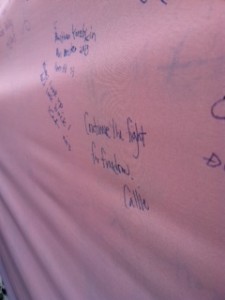The following post is part 2 in a blog series following Callie Hawkins, Associate Director for Programs at President Lincoln’s Cottage, in Southeast Asia on an awareness trip inspired by our current special exhibit, Can You Walk Away?. For more information on Can You Walk Away? and modern slavery in the United States, please visit www.lincolncottage.org/canyouwalkaway.html.
“Ours is not the task of fixing the entire world at once, but of stretching out to mend the part of the world that is within our reach.” Dr. Clarissa Pinkola Estés
As I came to write my first post from the road, I was struggling with how I might share what I experienced today, when I’m not sure I’ve fully processed it myself. A few moments ago, I received the above quote in an email from one of my fellow travelers. It’s such a timely message, as I think we’re all a little overwhelmed by the pervasiveness of modern slavery in the areas we’ve seen today. While we’ve all been deeply saddened by the things we’ve seen so far, we also see glimpses of hope in the work that lies ahead in the work that is being done here and in the work that lies ahead of our respective organizations. But, there has to be a constant vigilance, a constant call to act on every tier until slavery is completely eradicated.
The conversation naturally turned to history and to the work of those like Abraham Lincoln who answered the call of their time and did what they could do to “mend the part of the world that [was] within their reach.” It wasn’t easy, and it wasn’t fast, but it did end legal slavery as they knew it in their time.
Lincoln answered this call. Will you?
 Callie left this reflection behind at the top of the Temple of Dawn, a Buddhist temple in Bangkok. Visitors could leave behind comments and reflections on a cloth encircling the entire top of the Temple.
Callie left this reflection behind at the top of the Temple of Dawn, a Buddhist temple in Bangkok. Visitors could leave behind comments and reflections on a cloth encircling the entire top of the Temple.
***
In February 2012, President Lincoln’s Cottage unveiled Can You Walk Away? Modern Slavery: Human Trafficking in the United States. This special exhibit challenges perceptions of slavery in America today and raises awareness of a growing humanitarian crisis. By posing the question, “Can you walk away?” this exhibit inspires people to engage with the modern abolitionist movement and to see that slavery is an ongoing issue that requires big thinking and direction action, just as it did in Lincoln’s time. First Lady Laura Bush endorsed the exhibit, calling it “an invaluable lens through which the public can view our country’s ongoing struggle with slavery — both in the historical context and in present day trafficking. Exhibits like this are evidence of the way historic places can shape the way we live in the present.” Can You Walk Away? was created in partnership with the Polaris Project, the leading NGO in the United States fighting modern-day slavery. The exhibit is schedule to run through August 2013 in the Robert H. Smith Visitor Education Center.
Polaris Project is a leading organization in the global fight against human trafficking and modern-day slavery. Named after the North Star “Polaris” that guided people escaping slavery along the Underground Railroad, Polaris Project is transforming the way that individuals and communities respond to human trafficking, in the U.S. and globally. By successfully pushing for stronger federal and state laws, operating the National Human Trafficking Resource Center hotline (1-888-373-7888), conducting trainings, and providing vital services to victims of trafficking, Polaris Project creates long-term solutions that move our society closer to a world without slavery. Learn more at www.polarisproject.org.
Students Opposing Slavery is a student run organization that is committed to improving the world by raising awareness for human trafficking, a form of modern day slavery where people profit from the control and exploitation of others. For more information visit http://studentsopposingslavery.org/.
